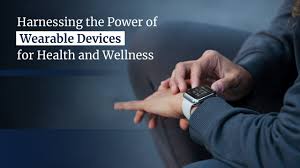Discover how wearables are transforming wellness with cutting-edge technology, offering innovative solutions to monitor health and improve lifestyle habits.
In today’s fast-paced world, staying healthy can be a challenge. Fortunately, technology is stepping up to fill the gap. Wearable devices, such as smartwatches and fitness trackers, are revolutionizing wellness by enabling users to monitor their health, track fitness goals, and adopt healthier lifestyles. This article explores how wellness and wearables intersect, providing practical insights into how technology can improve health outcomes and enhance daily living.
The Rise of Wearables in Wellness
What Are Wearables?
Wearables are electronic devices worn on the body that collect data about the user’s physical activity, health metrics, and environment. Popular examples include:
- Smartwatches: Devices like the Apple Watch and Samsung Galaxy Watch monitor heart rate, steps, and sleep patterns.
- Fitness Trackers: Gadgets like Fitbit and Garmin track physical activity, including running, cycling, and calorie burn.
- Health Monitors: Advanced devices, such as glucose monitors and ECG sensors, cater to specific medical needs.
Why Are Wearables Popular?
The popularity of wearables can be attributed to:
- Convenience: Easy-to-wear devices that integrate seamlessly into daily life.
- Personalization: Customizable settings to align with individual health goals.
- Real-Time Feedback: Immediate data on physical performance and health metrics.
Key Benefits of Wearables for Wellness
1. Activity Tracking
Wearables make it easy to track physical activities like walking, running, or cycling. These devices provide data on:
- Steps taken
- Calories burned
- Active minutes
This data helps users set and achieve fitness goals, fostering a more active lifestyle.
2. Sleep Monitoring
Sleep is critical for overall wellness. Many wearables include sleep tracking features, measuring:
- Duration of sleep
- Sleep stages (light, deep, REM)
- Sleep quality
This information helps users improve their sleep hygiene, which is essential for mental and physical health.
3. Heart Health
Heart rate monitoring is a core feature of most wearables. Advanced models can even detect irregular heart rhythms (arrhythmias) and provide alerts for potential health risks.
4. Chronic Disease Management
For individuals with chronic conditions, wearables offer significant advantages:
- Continuous glucose monitoring for diabetes.
- Blood pressure monitoring.
- Alerts for abnormal readings.
5. Stress and Mental Health Monitoring
Wearables often include stress management tools, such as:
- Guided breathing exercises.
- Stress level tracking based on heart rate variability.
These features support mental health by encouraging mindfulness and relaxation.
Wearables and the Future of Preventive Healthcare
Proactive Health Management
With wearables, users can detect early warning signs of potential health issues. For example, a consistent increase in resting heart rate may indicate stress or illness, prompting timely medical consultation.
Integration with Healthcare Providers
Many wearables now integrate with healthcare systems, allowing:
- Sharing data with doctors for accurate diagnoses.
- Remote patient monitoring, reducing hospital visits.
- Personalized treatment plans based on real-time data.
AI and Wearables
Artificial Intelligence (AI) is enhancing the capabilities of wearables by:
- Analyzing large datasets to provide actionable insights.
- Predicting health trends based on user behavior.
- Customizing recommendations to fit individual needs.
Challenges and Limitations
While wearables offer immense benefits, they are not without challenges:
1. Accuracy Concerns
Although improving, some wearables may provide inconsistent data, especially in activities requiring precise measurements.
2. Privacy and Security
Data security is a significant concern. Wearables collect sensitive health information, and users must ensure their data is protected.
3. Cost
High-quality wearables can be expensive, potentially limiting access for some users.
Choosing the Right Wearable for Your Wellness Goals
Factors to Consider
- Purpose: Identify your primary health goal (e.g., fitness tracking, sleep monitoring).
- Compatibility: Ensure compatibility with your smartphone and other devices.
- Features: Look for specific features like heart rate monitoring, GPS, or waterproofing.
- Budget: Choose a device that fits your financial plan without compromising quality.
Top Wearable Brands
- Apple Watch: Ideal for tech enthusiasts seeking comprehensive health monitoring.
- Fitbit: Great for fitness-focused individuals.
- Garmin: Perfect for athletes and outdoor adventurers.
- Oura Ring: Specialized in sleep and recovery tracking.
Real-Life Impact: Success Stories
Example 1: Weight Loss Journey
A 35-year-old used a Fitbit to track daily steps and caloric intake, leading to a 30-pound weight loss in six months.
Example 2: Detecting Atrial Fibrillation
An Apple Watch alerted a user to an irregular heartbeat, enabling early detection and treatment of atrial fibrillation.
Conclusion
Wearables are more than just gadgets—they are powerful tools for enhancing wellness. By offering insights into activity levels, sleep quality, heart health, and more, these devices empower individuals to take charge of their health. As technology continues to evolve, wearables will play an even greater role in preventive healthcare, helping users live healthier, happier lives.
FAQs
1. What are the main benefits of wearables for wellness?
Wearables help track physical activity, monitor sleep, manage chronic conditions, and support mental health through stress management tools.
2. Are wearables accurate?
While most wearables are reasonably accurate, factors like device quality and usage can affect precision.
3. Can wearables replace regular medical check-ups?
No, wearables are not a substitute for professional medical advice or check-ups but can complement healthcare by providing useful data.
4. How do wearables protect my data?
Reputable brands use encryption and secure protocols to safeguard user data. Always check privacy policies before purchasing.
5. Which wearable is best for beginners?
Devices like Fitbit Inspire or Xiaomi Mi Band are affordable and user-friendly, making them great for beginners.